| Article ID | Journal | Published Year | Pages | File Type |
|---|---|---|---|---|
| 5366599 | Applied Surface Science | 2009 | 9 Pages |
Surface functionalization of multi-walled carbon nanotubes (MWCNTs), with amino groups via chemical modification of carboxyl groups introduced on the nanotube surface, using O-(7-azabenzotriazol-1-yl)-N,N,Nâ²,Nâ²-tetramethyluronium hexafluorophosphate (N-HATU) and N,N-diisopropylethylamine (DIEA) is reported. The N-HATU coupling agent provides faster reaction rate and the reaction occurs at lower temperature compared to amidation and acylation-amidation chemistry. The amines, 1,6-hexanediamine (HDA), diethylenetriamine (DETA), triethylenetetramine (TETA) and 1,4-phenylenediamine (PDA) were used. The resulting materials were characterized with different techniques such as FTIR, XRD, elemental analysis, TGA, TEM, UV-vis spectroscopy and cyclic voltammetry. MWCNTs functionalized with PDA posses the best dispersibility and electron transfer properties in comparison to the others amines. Functionalized MWCNTs, at the concentrations between 1 and 50 μg mlâ1, were not cytotoxic for the fibroblast L929 cell line. However, the concentrations of MWCNTs higher of 10 μg mlâ1 reduced cell growth and this effect correlated positively with the degree of their uptake by L929 cells.
